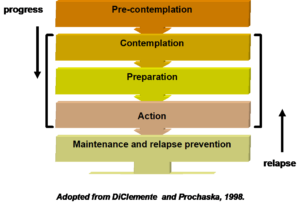
The Anatomy of Coaching Led Change
The ultimate test of a coaching engagement is often the visible change that your client is able to demonstrate to herself or himself, to you and of course to his or her sponsor.
Often times, in the course of our engagement, we and the client believe that this process of change has indeed begun – it is evident from your interactions, from you sense of his receptiveness, from his genuine acceptance and his visible commitment. Yet, you may be unable to show clear evidence of this change early enough. More importantly, you are often unable to convince the occasionally impatient sponsor that the process of change has indeed begun.
You may even feel like appealing to the sponsor: “Hey, you know what, my client has indeed begun to change and that is true. If you try hard, you can see it for yourself!”
So, is it possible that someone has begun to change but you and others are yet unable to see it? Is there an invisible work in progress state?
As I began to research this, I stumbled up this interesting five stage model of change developed by DiClemente and Prochaska (1998). This model helped me answer this question rather well.
The fundamental premise behind their model is that behavioural change is seldom a single discreet event – a switch which goes from off to on.
The model suggests that change is often a gradual slow process that people go through over a period of time, starting with first being unaware and uninterested and even unwilling to change (pre-contemplation stage) to then moving to a stage where the person is considering the need to change (contemplation) to a stage where the person is deciding and actually preparing for the change (preparation) to a stage where the person is taking specific action towards the change and (action) to finally a stage where the person will maintain the change momentum and prevent relapse (maintenance).

When we apply this model to a typical coaching situation, things begin to suddenly fall in place.
Pre-contemplation
At this stage the person has not yet begun to see the need for change and believes that current styles and approaches are fine. This is where we commence our coaching journey. This is the stage where we begin to listen to the stories of our clients and also build a trusting relationship through our empathy and understanding.
Contemplation
At this stage, the person has begun to think about the need for change. This is achieved by bringing new perspectives and challenging old ways through feedback and assessment. Through this, the person is beginning to become open to the need for change. The person is also looking at how things will get better with change and begins to make a firm decision to change.
Preparation
At this stage, the person starts preparing to make the change. This involves establishing a clear goal, evolving action strategies and drawing up implementation plans. This is a stage of transition and therefore accompanied by a certain sense of uncertainty.
Action
This is the stage in which the person actually takes steps to attempt new behaviour. The person tries new things and puts plans into action. There is bound to be trial and error as the person embarks on a new path.
Maintenance and relapse prevention
This is the all-important phase of making the change sustainable. This is the stage where the coach needs to help the client stay committed and ultimately become an advocate for others to change.
The fine lines separating Contemplation – Preparation – Action
In reality, clients may spend a fair amount of time in contemplation and preparation, in thinking through the new inputs, figuring out the pros and cons, getting to grips with potential behaviours and so on.
However, while all this is happening, we or even the sponsors may not see visible change. However, if we are truly insightful and empathetic, we can sense that the client is contemplating and preparing.
These are the stages where we as coaches therefore actually invest the most effort. Similarly, clients may also take a lot of time in mastering actions. Often, there is a fair amount of relapse from action back to contemplation and revised preparations during this period.
I believe that it is important firstly for us as coaches to recognise these often-invisible stages in the change process and be a lot more empathetic with our clients as they navigate these stages. It is equally important for us to use this awareness to gently sensitize our sponsors and even set realistic expectations. Of course, we must adopt innovative stage relevant tools and intervention strategies to help clients move forward.
Beyond all this, it is important that we recognise that behavioural change is a deeply human process that is bound to have multitudes of layers and its inevitable motions of progress and relapse before launching into sustainable change.
In that sense, behavioural change is more akin to metamorphosis than to turning on the light!
-Ganesh Chella
